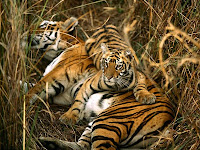
A Macaw
 Some of the species are known for their impressive sizes. Hyacinth Macaw is the largest parrot in length and wingspan.
Some of the species are known for their impressive sizes. Hyacinth Macaw is the largest parrot in length and wingspan.They feed on fruits, nuts, insects and snails. Some species eat damp clay soil called clay licks which neutralize chemicals produced by their fruity diet and also provide them with Sodium. These birds have large powerful beaks that easily crack nuts and seeds. Their dry scaly tongues have a bone for tapping into fruits. Macaws are intelligent, social birds that often gather in flocks of 10 to 30 individuals. Macaws vocalize to communicate within the flock, mark territory, and identify one another. Some species can even mimic human speech.
Majority of Macaw's are now endangered in the wild. Six species are already extinct. The greatest problem threatening the Macaw population is rapid deforestation and illegal trapping of birds for trade. International trade of all Macaw species is regulated by Convention On International Trade In Endangered Species [CITES]
Which Macaw Should I Buy? How Do They Behave?
 There are 2 types of Macaw's on the basis of size. Either Large Macaws or Mini Macaws. Sizes of large Macaws range from 20-42 inches and include various common species like Hyacinth Macaw [largest], Blue and Gold Macaw, Military Macaw, Scarlet Macaw, Spix's Macau etc. Mini Macaw's are more easily managed at 10-20 inches but are more uncommon. Mini Macaw's include Severe Macaw, Hahn's Macaw [Noble Macaw], Yellow Collared Macaw etc.
There are 2 types of Macaw's on the basis of size. Either Large Macaws or Mini Macaws. Sizes of large Macaws range from 20-42 inches and include various common species like Hyacinth Macaw [largest], Blue and Gold Macaw, Military Macaw, Scarlet Macaw, Spix's Macau etc. Mini Macaw's are more easily managed at 10-20 inches but are more uncommon. Mini Macaw's include Severe Macaw, Hahn's Macaw [Noble Macaw], Yellow Collared Macaw etc..jpg) Macaw's have a good life span of about 30-50 years. A healthy large Macaw is expected to easily live out half a century while Mini macaw live near 30 years. If I were to buy this wonderful bird, then i would have gone for a brightly colored one irrespective of its size. Most common choices of these birds are Hyacinth, Scarlet and Blue n Gold Macaw. Glaucous and Military Macaws are also good options. If u wanna go for something unique for collection then you can go for a hybrid.
Macaw's have a good life span of about 30-50 years. A healthy large Macaw is expected to easily live out half a century while Mini macaw live near 30 years. If I were to buy this wonderful bird, then i would have gone for a brightly colored one irrespective of its size. Most common choices of these birds are Hyacinth, Scarlet and Blue n Gold Macaw. Glaucous and Military Macaws are also good options. If u wanna go for something unique for collection then you can go for a hybrid. Macaws are playful and active birds and have an exuberant personality to go with their size. They are smart and inquisitive as well as being playful and lively. They are very affectionate and in turn require a good deal of time and attention from their owners to be happy [Toys Too]. Macaws are also very noisy and their screeches are usually very loud. They also do mimic sounds but not as clearly as other parrots. They are very challenging pets but adapt easily to captivity, they are tamed quickly and create a bond with their owners.
What Do They Require?
Macaws need a large, strong cage so be prepared to make a significant investment. Mini macaws can be kept in cage sized for Amazons (24x36x48). However, larger macaws need a cage at least 36x48x60 and the cage should be strong enough to withstand their significant beak strength of macaws. A stainless steel cage is a good investment.
A wide variety of wooden toys or plain untreated chunks of wood to chew on should be provided. Toys meant to be taken apart to get at a treat are also a good choice, as are hanging toys and toys to climb on as as they are safe
The diet required for a macaw starts with pelleted food which is supplemented with a wide range of healthy fresh foods (grains, vegetables, fruits). Pellets can make upto 25-50% of the diet, But seeds should not be provided more than 10% in the diet as they are too high in fat. Nuts are also a good treat in moderation.
Products Needed.
I am the one on left .........................
Place : Tamanburung Bird Park , KL , Malaysia









































 may become of an eggplant shape
may become of an eggplant shape






